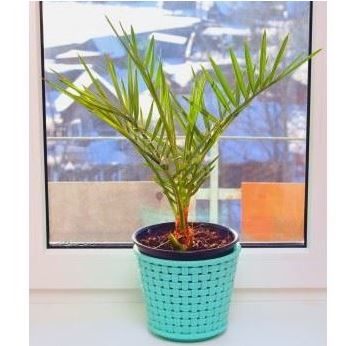
How it looks and displaying: As mentioned above the Pygmy palm has very slim feather type leaflets that arch over. The only other palm I know of that has slimmer leaves is the dwarf coconut type, while others are much wider and can look more attractive indoors.
The trunk is an attractive feature that grows up to 6 inches in diameter, and brown in color. Outdoors these only grow up to 6 - 10ft, so they're a manageable height indoors and outside (in the correct conditions). These are suitable to be grown and displayed in greenhouses, conservatories or any room that has enough bright light.
Easy to grow: You will see after reading the care instructions that the Phoenix roebelenii is fairly easy to grow and maintain. Some growers will produce plants with two or three trunks from seedlings next to each other.
Facts
Origin:
South-East-Asia.
Names:
Pygmy date, Miniature date palm (common). Phoenix roebelenii (botanical/scientific.
Max Growth (approx):
Height 6ft.
Poisonous for pets:
Non-toxic to cats and dogs.

Date Palm Care
Temperature:
Room temperatures of around 65°f / 16°c --- 75°f / 24°c are ideal.
The temperature should not become lower than 50°f / 10°c during winter.
Light:
They prefer bright light with a mixture of sunlight and shade.
Watering:
You can water these frequently during spring and summer - when the top of the soil starts to become slightly dry. Over-watering will cause this plant possible root and leaf problems, or worse (kill it off). A good drainage container is advisable to house the plant. I find watering and misting with tepid filtered or distilled water is best used to avoid growing problems.
Soil:
A fast draining peat based potting soil is fine to use.
Re-Potting:
Palms generally dislike being removed from a pot. The best practice is to re-pot only, when it has become pot bound and take good care of the roots whilst doing so. Keep in mind that they do like being slightly pot bound. When re-potting just use a pot slightly bigger than the previous one, if it's pot-bound and pack soil around the roots.
Fertilizer:
I would fertilize these about once a month from spring - fall with a diluted liquid fertiliser and none during winter.
Humidity:
The pygmy enjoys misting if the room gets humid, and gently sponging the fronds with water is helpful. Make sure there are no cold drafts near your palm.
Propagation:
These are propagated by seed at approximately 80ฐf / 26.6ฐc. Usually professional growers propagate these because of the conditions (light and temperature) needed for several weeks or so, before they germinate.
Potential problems: See the palm category page for the section about potential problems »







